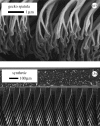Rate-dependent frictional adhesion in natural and synthetic gecko setae
- PMID: 19493896
- PMCID: PMC2842608
- DOI: 10.1098/rsif.2009.0133
Rate-dependent frictional adhesion in natural and synthetic gecko setae
Abstract
Geckos owe their remarkable stickiness to millions of dry, hard setae on their toes. In this study, we discovered that gecko setae stick more strongly the faster they slide, and do not wear out after 30,000 cycles. This is surprising because friction between dry, hard, macroscopic materials typically decreases at the onset of sliding, and as velocity increases, friction continues to decrease because of a reduction in the number of interfacial contacts, due in part to wear. Gecko setae did not exhibit the decrease in adhesion or friction characteristic of a transition from static to kinetic contact mechanics. Instead, friction and adhesion forces increased at the onset of sliding and continued to increase with shear speed from 500 nm s(-1) to 158 mm s(-1). To explain how apparently fluid-like, wear-free dynamic friction and adhesion occur macroscopically in a dry, hard solid, we proposed a model based on a population of nanoscopic stick-slip events. In the model, contact elements are either in static contact or in the process of slipping to a new static contact. If stick-slip events are uncorrelated, the model further predicted that contact forces should increase to a critical velocity (V*) and then decrease at velocities greater than V*. We hypothesized that, like natural gecko setae, but unlike any conventional adhesive, gecko-like synthetic adhesives (GSAs) could adhere while sliding. To test the generality of our results and the validity of our model, we fabricated a GSA using a hard silicone polymer. While sliding, the GSA exhibited steady-state adhesion and velocity dependence similar to that of gecko setae. Observations at the interface indicated that macroscopically smooth sliding of the GSA emerged from randomly occurring stick-slip events in the population of flexible fibrils, confirming our model predictions.
Figures





Similar articles
-
Frictional adhesion: A new angle on gecko attachment.J Exp Biol. 2006 Sep;209(Pt 18):3569-79. doi: 10.1242/jeb.02486. J Exp Biol. 2006. PMID: 16943497
-
Role of tilted adhesion fibrils (setae) in the adhesion and locomotion of gecko-like systems.J Phys Chem B. 2009 Mar 26;113(12):3615-21. doi: 10.1021/jp806079d. J Phys Chem B. 2009. PMID: 19673126
-
Effective elastic modulus of isolated gecko setal arrays.J Exp Biol. 2006 Sep;209(Pt 18):3558-68. doi: 10.1242/jeb.02469. J Exp Biol. 2006. PMID: 16943496
-
Review: mapping proteins localized in adhesive setae of the tokay gecko and their possible influence on the mechanism of adhesion.Protoplasma. 2018 Nov;255(6):1785-1797. doi: 10.1007/s00709-018-1270-9. Epub 2018 Jun 7. Protoplasma. 2018. PMID: 29881974 Review.
-
Sticking to the story: outstanding challenges in gecko-inspired adhesives.J Exp Biol. 2016 Apr;219(Pt 7):912-9. doi: 10.1242/jeb.080085. J Exp Biol. 2016. PMID: 27030772 Review.
Cited by
-
Contact compliance effects in the frictional response of bioinspired fibrillar adhesives.J R Soc Interface. 2013 Apr 3;10(83):20130182. doi: 10.1098/rsif.2013.0182. Print 2013 Jun 6. J R Soc Interface. 2013. PMID: 23554349 Free PMC article.
-
Understanding the influence of silicone elastomer properties on wedge-shaped microstructured dry adhesives loaded in shear.J R Soc Interface. 2018 Sep 19;15(146):20180551. doi: 10.1098/rsif.2018.0551. J R Soc Interface. 2018. PMID: 30232245 Free PMC article.
-
Simulation of synthetic gecko arrays shearing on rough surfaces.J R Soc Interface. 2014 Apr 2;11(95):20140021. doi: 10.1098/rsif.2014.0021. Print 2014 Jun 6. J R Soc Interface. 2014. PMID: 24694893 Free PMC article.
-
Tails stabilize landing of gliding geckos crashing head-first into tree trunks.Commun Biol. 2021 Sep 2;4(1):1020. doi: 10.1038/s42003-021-02378-6. Commun Biol. 2021. PMID: 34475510 Free PMC article.
-
Active contacts control sliding friction.Proc Natl Acad Sci U S A. 2025 Jul 15;122(28):e2501169122. doi: 10.1073/pnas.2501169122. Epub 2025 Jul 9. Proc Natl Acad Sci U S A. 2025. PMID: 40632573
References
-
- Aristotle 350 BCE 1918. Historia animalium (transl. by Thompson D. W.). Oxford, UK: The Clarendon Press.
-
- Autumn K. 2006. Properties, principles, and parameters of the gecko adhesive system. In Biological adhesives (eds Smith A., Callow J.), pp. 225–255. Berlin, Germany: Springer Verlag.
Publication types
MeSH terms
Substances
LinkOut - more resources
Full Text Sources
Miscellaneous

